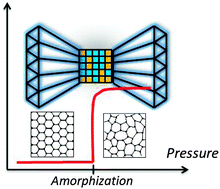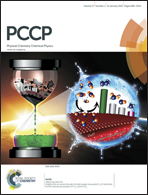Size-dependent pressure-induced amorphization: a thermodynamic panorama†
Abstract
Below a critical particle size, some pressurized compounds (e.g. TiO2, Y2O3, PbTe) undergo a crystal-to-amorphous transformation instead of a polymorphic transition. This effect reflects the greater propensity of nanomaterials for amorphization. In this work, a panorama of thermodynamic interpretations is given: first, a descriptive analysis based on the energy landscape concept gives a general comprehension of the balance between thermodynamics and kinetics to obtain an amorphous state. Then, a formal approach based on Gibbs energy to describe the thermodynamics and phase transitions in nanoparticles gives a basic explanation of size-dependent pressure-induced amorphization. The features of this transformation (amorphization occurs at pressures lower than the polymorphic transition pressure!) and the nanostructuration can be explained in an elaborated model based on the Ginzburg–Landau theory of phase transition and on percolation theory. It is shown that the crossover between polymorphic transition and amorphization is highly dependent on the defect density and interfacial energy, i.e., on the synthesis process. Their behavior at high pressure is a quality control test for the nanoparticles.


 Please wait while we load your content...
Please wait while we load your content...